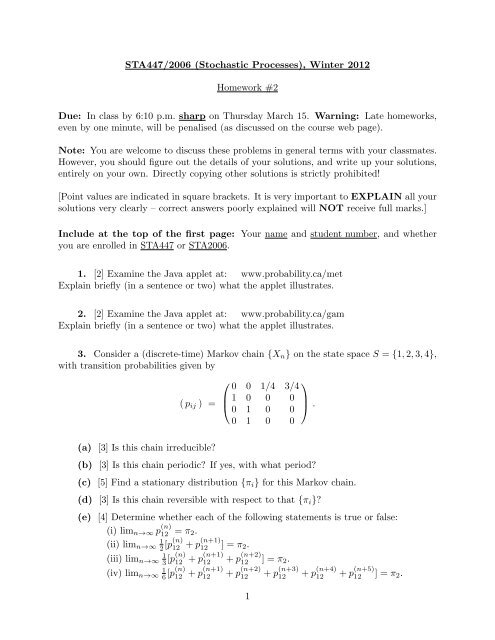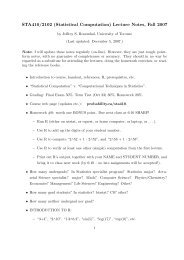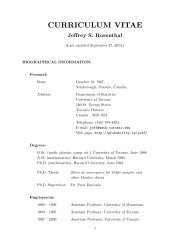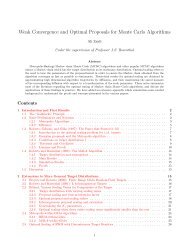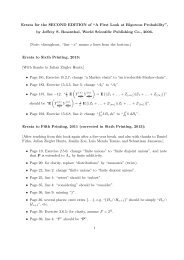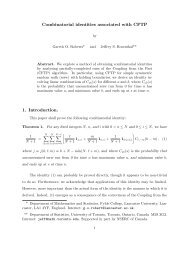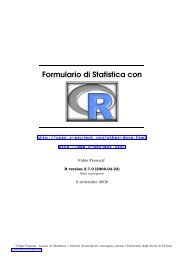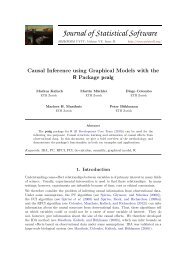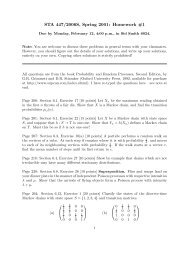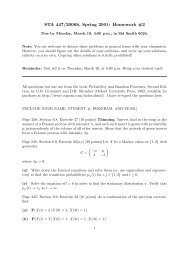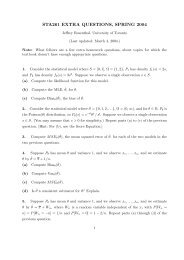Homework #2 - probability.ca
Homework #2 - probability.ca
Homework #2 - probability.ca
You also want an ePaper? Increase the reach of your titles
YUMPU automatically turns print PDFs into web optimized ePapers that Google loves.
STA447/2006 (Stochastic Processes), Winter 2012<br />
<strong>Homework</strong> <strong>#2</strong><br />
Due: In class by 6:10 p.m. sharp on Thursday March 15. Warning: Late homeworks,<br />
even by one minute, will be penalised (as discussed on the course web page).<br />
Note: You are welcome to discuss these problems in general terms with your classmates.<br />
However, you should figure out the details of your solutions, and write up your solutions,<br />
entirely on your own. Directly copying other solutions is strictly prohibited!<br />
[Point values are indi<strong>ca</strong>ted in square brackets. It is very important to EXPLAIN all your<br />
solutions very clearly – correct answers poorly explained will NOT receive full marks.]<br />
Include at the top of the first page: Your name and student number, and whether<br />
you are enrolled in STA447 or STA2006.<br />
1. [2] Examine the Java applet at: www.<strong>probability</strong>.<strong>ca</strong>/met<br />
Explain briefly (in a sentence or two) what the applet illustrates.<br />
2. [2] Examine the Java applet at: www.<strong>probability</strong>.<strong>ca</strong>/gam<br />
Explain briefly (in a sentence or two) what the applet illustrates.<br />
3. Consider a (discrete-time) Markov chain {X n } on the state space S = {1, 2, 3, 4},<br />
with transition probabilities given by<br />
( p ij ) =<br />
(a) [3] Is this chain irreducible?<br />
⎛<br />
⎞<br />
0 0 1/4 3/4<br />
⎜ 1 0 0 0 ⎟<br />
⎝<br />
⎠ .<br />
0 1 0 0<br />
0 1 0 0<br />
(b) [3] Is this chain periodic? If yes, with what period?<br />
(c) [5] Find a stationary distribution {π i } for this Markov chain.<br />
(d) [3] Is this chain reversible with respect to that {π i }?<br />
(e) [4] Determine whether each of the following statements is true or false:<br />
(i) lim n→∞ p (n)<br />
12 = π 2.<br />
(ii) lim n→∞<br />
1<br />
2 [p(n) 12 + p(n+1) 12 ] = π 2 .<br />
1<br />
(iii) lim n→∞ 3 [p(n) 12 + p(n+1) 12 + p (n+2)<br />
12 ] = π 2 .<br />
1<br />
(iv) lim n→∞ 6 [p(n) 12 + p(n+1) 12 + p (n+2)<br />
12 + p (n+3)<br />
12 + p (n+4)<br />
12 + p (n+5)<br />
12 ] = π 2 .<br />
1
4. Consider the undirected graph on the vertices V = {1, 2, 3, 4, 5}, with weights<br />
given by w(1, 2) = w(2, 1) = w(2, 3) = w(3, 2) = w(1, 3) = w(3, 1) = w(3, 4) = w(4, 3) =<br />
w(3, 5) = w(5, 3) = 1, and w(u, v) = 0 otherwise.<br />
(a) [3] Draw a picture of this graph.<br />
(b) [10] Compute (with full explanation) lim n→∞ P[X n = 3], where {X n } is the<br />
usual (simple) random walk on this graph.<br />
5. [10] Let {X n } be simple random walk on S = Z, with parameter p = 2/3, and with<br />
X 0 = 5. For any i ∈ Z, let T i = inf{n ≥ 1 : X n = i}. Compute (with full explanation)<br />
P 5 (T 0 < ∞). [Hint: First, use the Gambler’s Ruin formula to compute P 5 (T c < T 0 ), and<br />
hence P 5 (T 0 < T c ), for any c > 6. Then, consider (with justifi<strong>ca</strong>tion) the limit as c → ∞.]<br />
6. [A special <strong>ca</strong>se of the Gibbs Sampler.] Let S = Z × Z, and let f : S → (0, ∞) be<br />
some function from S to the positive real numbers. Let K = ∑ (x,y)∈S<br />
f(x, y), and assume<br />
that K < ∞. For x, y ∈ Z, let C(x) = ∑ w∈Z f(x, w), and R(y) = ∑ z∈Z<br />
f(z, y). Consider<br />
a Markov chain on S with transition probabilities given by<br />
(a) [5] Prove that<br />
p (x,y),(z,w) =<br />
∑<br />
(z,w)∈S<br />
⎧<br />
⎪⎨<br />
⎪⎩<br />
f(z, w) f(z, w)<br />
+<br />
2 C(x) 2 R(y) , x = z and y = w<br />
f(z, w)<br />
2 C(x) , x = z and y ≠ w<br />
f(z, w)<br />
2 R(y) , x ≠ z and y = w<br />
0 , otherwise<br />
p (x,y),(z,w) = 1 for all (x, y) ∈ S.<br />
(b) [5] Show that the chain is reversible with respect to π (x,y) = f(x,y)<br />
K .<br />
(c) [10] Compute lim<br />
n→∞ p(n) (x,y),(z,w)<br />
for all x, y, z, w ∈ Z (<strong>ca</strong>refully justifying each step).<br />
7. Let {Z i } be an i.i.d. collection of random variables with P[Z i = −1] = 3/4 and<br />
P[Z i = C] = 1/4, for some C > 0. Let X 0 = 5, and X n = 5 + Z 1 + Z 2 + . . . + Z n for n ≥ 1.<br />
Finally, let T = inf{n ≥ 1 : X n = 0 or Z n > 0}.<br />
(a) [5] Find (with explanation) a value of C such that {X n } is a martingale.<br />
(b) [2] For this value of C, compute (with explanation) E(X 9 ).<br />
(c) [3] For this value of C, compute (with explanation) E(X T ). [Hint: is T bounded?]<br />
2


